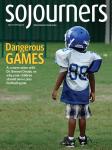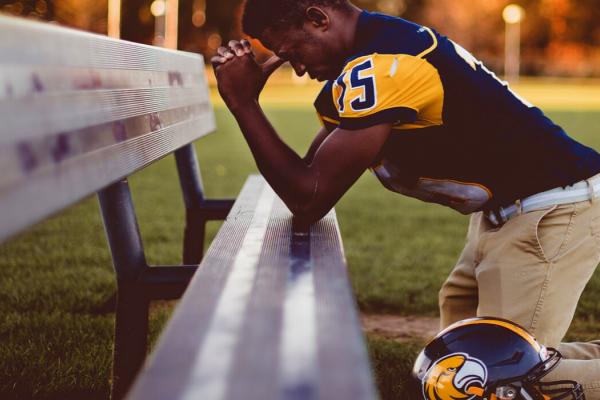Editors’ note: This article appeared in Sojourners magazine in 2018. In 2020, a Washington Post article by Will Hobson raised concerns about some of Bennet Omalu’s conclusions on chronic traumatic encephalopathy (CTE). Ongoing research suggests that CTE is a risk for NFL players, but the rate and severity of the brain disease among football players is still being studied.
DR. BENNET OMALU is well-acquainted with gruesome deaths. “Some people wake up in the morning, put on their suits, go to offices, and to do things associated with life, with living. But me,” Omalu says from behind the office desk in his Sacramento-area home, “I dress up, I go to work to do things associated with the greatest weaknesses of [humanity].”
A forensic pathologist and neuropathologist who earned degrees in his native Nigeria and in various schools across the U.S., Omalu was most recently in the news for performing an independent autopsy on Stephon Clark, an unarmed black man killed in his own backyard. Omalu’s work confirmed that Clark was shot in the back six times by Sacramento police.
Omalu is best known, however, for the startling discovery he made after performing an autopsy on former NFL player Mike Webster. As chronicled in the 2015 film Concussion, with Will Smith starring as Omalu, the then-medical examiner in Pittsburgh found Webster had chronic traumatic encephalopathy, a degenerative brain disease caused by repeated blows to the head—the kind of blows to the head you ought to expect when playing tackle football.
But despite his daily proximity to death, Omalu, a committed Catholic, has nothing but gratitude. “I am blessed because I encounter death every day ... I came to the world naked, cold, and lonely, and I will leave the world alone, cold, and lonely,” he explains. “When you realize that, you begin to think of powers, realities, dimensions that are beyond you.”
Omalu is precise and careful with his words. When he says, “I let the Spirit of God percolate into my being,” I half expect to hear his celestial brew bubble. “Everything I do, I do through the eyes of faith.”
Omalu doesn’t seem to be exaggerating; his Christian beliefs and morals permeate his outlook on everything. Early in our conversation, he asks if I’m a Christian writer, and I try to say I’m more like a Christian who writes, but Omalu isn’t one to thread the needle between competing postmodern definitions of Christian vocation. The Bible on his desk is as important to him as any medical textbook—and based on its proximity to his laptop, he might use the Bible more often.
And it’s with this same precision that Omalu offers an uncompromising assessment of the sport running U.S. recreational life each Saturday and Sunday (plus Monday nights on ESPN, Fridays if you’re in high school, and it’s even trying to make Thursdays a thing) for about six months out of the year.
He says, with the utmost clarity and conviction, “It is not of God.”
American gladiators
In 2003, several months after he performed an autopsy on former Pittsburgh Steeler Mike Webster, Omalu took a closer look at the Hall of Fame player’s brain, which had been preserved on slides for further study. Webster died of a heart attack but had undergone severe physical and psychological turmoil in his final years, often shocking himself repeatedly with a police-grade Taser gun to calm his nerves. When placed under a microscope, the man’s brain looked unlike anything Omalu had seen.
“These slides did not appear like they should belong to a 50-year-old man,” Omalu writes in his memoir, Truth Doesn’t Have a Side. “Each slide contained numerous brain cells, yet many had died and disappeared. ... A large number of the remaining cells appeared shriveled, as if in the midst of the throes of death.”
He later understood this brain to suffer the condition we now know as chronic traumatic encephalopathy, or CTE. The young Pittsburgh-based pathologist published his findings, and the rest of his world turned upside down. In 2006, the NFL’s concussion committee, a group that curiously did not have a single neuropathologist, demanded that he retract his statement. The Steelers’ team physician, Dr. Joseph Maroon, dismissed Omalu’s research as “purely speculative” and “not appropriate science.”
Nonscientists weighed in, too. Indianapolis Colts’ owner Jim Irsay compared the risks of playing football to taking aspirin.
Media smears provoked anonymous racist attacks, with devastating consequences for Omalu’s personal life with his wife, Prema Mutiso. “Phone calls started coming to the house—threatening calls,” Omalu wrote. “People told me to go back to the jungle where I had come from. They threatened me and my family. I then started noticing cars following me. And I wasn’t just being paranoid.”
Omalu traces some similarities between his life and that of St. Telemachus, an early-church monk believed to have sacrificed his life in protest against a gladiator battle. “In the name of Christ, stop!” the ancient monk yelled at the amphitheater crowd and the contestants battling with sword and shield, drawing their ire and, eventually, their stones.
It’s a sobering comparison. But if Omalu was ever concerned that a billion-dollar corporation was attempting to detonate his career, he doesn’t show it. He retells the Socratic cat-and-mouse he plays with people concerned for his professional and personal well-being: “People have asked me, ‘Bennet—the NFL, you were not afraid?’ I asked, ‘Afraid of what? Afraid of being caught doing what? What should I be afraid of?’ They said, ‘Weren’t you afraid the NFL could hurt you?’”
Omalu’s reply? “‘Hurt me for what? And if they hurt me, what happens? Did they take my spirit from me? No.’”
‘We are in a public health crisis’
If you ask Omalu today, he’ll tell you that you should never, ever play football again. In his latest book, Brain Damage in Contact Sports: What Parents Should Know Before Letting Their Children Play , Omalu argues that no child under the age of 18 should play high-contact sports. He believes the public has an incentive to restrict football the same way the U.S. restricts cigarettes from minors.
When Omalu discusses football, he moves effortlessly between sterile scientific conclusions and moral claims. “We shouldn’t let children play because we are damaging their brains and robbing them of their humanity. That is a fact.”
The research is in his favor. A 2017 study from Boston University’s Chronic Traumatic Encephalopathy Center found that playing tackle football before age 12 can double the risk of developing behavioral problems later in life. The study also found that it triples the chance of depression.
Depression underscores Omalu’s concerns about football’s impact on the human brain. When Omalu was a young man studying medicine in Nigeria, he underwent an intense period of loneliness and despair, which he understands now as depression. That experience gave him a providential connection when he “met” Webster’s corpse. “Only those who have suffered depression can understand the darkness that descends upon one’s soul,” Omalu writes in his memoir. “That’s one of the reasons I believe my meeting him was truly an act of God. The Lord himself brought the two of us together, two very different men and yet connected by our battles with the darkness of depression.”
Why are people compelled to play a sport that, to Omalu, is so obviously linked with unceasing, nearly unbearable physical and emotional pain? Jack Moore, a journalist who suffered brain trauma as a college student while umpiring a Little League baseball game, has chronicled football’s history with preventing injury and believes that violence inflicted on the human body is ingrained in the sport’s DNA.
“Football has a very specific culture around masculinity and toughness that really demands you hide your pain,” Moore told me. He cites former president Teddy Roosevelt, who was an early advocate of football and its ability to fulfill a masculine ideal. “I believe in rough games and in rough, manly sports,” Roosevelt said in a 1903 speech. “I do not feel any particular sympathy for the person who gets battered about a good deal so long as it is not fatal.”
Today, Moore wonders how many battered men are walking around with nonfatal concussive injuries. But when it comes to exact numbers, Moore can only do back-of-a-napkin calculations; after all, CTE can only be confirmed via autopsy. (CTE may soon be reliably detectable in living people.)
Still, a recent Boston University study found 110 of 111 brains of former NFL players had CTE. The study acknowledged a clear selection bias: Many of the brains were from people who exhibited symptoms of serious brain trauma before they died. But even if we assume the percentage of players with CTE is tiny—for the sake of a thought experiment, Moore suggested one-tenth of 1 percent—and multiply it by the 1.23 million kids in grades six through 12 who played tackle football in 2015, we’re looking at more than 12,000 kids with the disease.
“When you’re talking about the sheer number of American men that have gone through public school institutionalized football for multiple years,” Moore asks, “What kind of risk of CTE are we talking about in the next 20 to 30 years?” To him, the answer is plain: “We are in a public health crisis.”
And as Omalu will readily remind you, CTE is not the only degree of brain trauma we should be concerned with. One can have brain damage without having that specific degenerative brain condition. Omalu argues that 100 percent of people that play football are at risk for head trauma. The Sanford Sports Science Institute estimates that middle school tackle football players receive an average of 250 hits to the head per season. According to researchers from the University of Michigan, that number jumps to 650 for high school players. In a 2016 editorial for the American Journal of Bioethics, Dr. Steven Miles and Dr. Shailendra Prasad urge health professionals to call for an end to tackle football programs in public schools.
Brain tissue as a ticket out
Though I love playing football, I embalmed myself in low expectations about my athletic career at an early age. And as someone solidly middle class—as solidly middle class as a black man in America can be—I had other career options.
Yet the median black household has a take-home income close to half that of white households. The average black family’s household wealth is about $140,000, compared to $919,000 for white families. Could the promise of a free college education and the potential riches of an NFL career sway someone to, in effect, use their brain tissue as currency, whatever the cost?
Let’s be clear: The NFL and the NCAA aren’t here to fix racial inequality. But it’s fair to ask if the league depends on labor extracted from persistent inequality. Even NBA great LeBron James interacted with this dynamic when explaining why he doesn’t allow his sons to play football even though he played when he was a kid. “I needed a way out,” said James, who this summer signed a $154 million contract with the Los Angeles Lakers. “My kids don’t need a way out. They’re all right.”
Omalu is keenly aware of this problem himself. “Black men make up about 5 to 6 percent of the U.S., right? But they’re 75 percent of the NFL. Why is that?”
Omalu uses two schools near his home, one public and one private, to illustrate why he thinks football could become a civil rights issue. “The public high school has a big football field. Twice a week in the season, there are so many cars parked. One day I pulled over to find out why there were so many cars. It turned out they were playing football. And I went to look. Over 95 percent of the players were black kids.” According to Omalu, the private school nearby may have black kids, but he’s not even sure if their school has a football field.
“We are undermining the intellectual capacity of black boys and black men. Mainstream America won’t care because it feeds into that narrative that black men are inferior.”
Omalu predicts that the criminal behavior one could associate with the effects of CTE will be written off as cultural pathology or inherent intellectual inferiority. “But you were the ones that damaged their minds,” he says.
Is God a football fan?
When my father—at the time a self-described radical, leftist, black activist—was in college in the ’70s, he liked to needle his Christian peers with disingenuous “gotcha” games about everyday moral quandaries. The one he remembers the most went something like:
Dad: Hey, friend! You’re a Christian, right?”
Friend: Yeah ...
Dad: But you like football?
Friend: Yeah, I do.
Dad: But wait—isn’t football violent? Aren’t Christians supposed to be about love and peace and goodwill? How could you root for people to injure someone?
He’d close it off by asking if Jesus would really cheer people on while they harmed each other.
Omalu tries not to judge people for watching football. Yet to anyone endeavoring to live a moral, convictional, and, most of all, Christian life, his charge is this: “If the way of the world is telling you: ‘Love football,’ but the Spirit of God is telling you, ‘This is not good,’ which will you listen to?”

Got something to say about what you're reading? We value your feedback!

